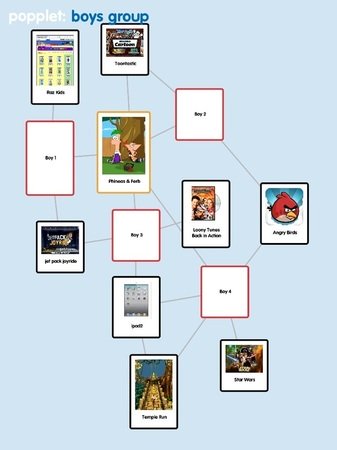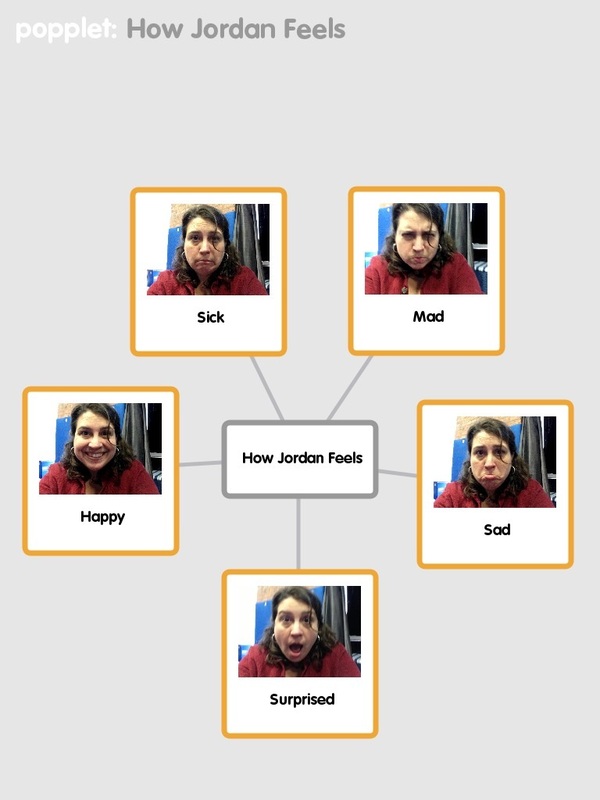With autistic learners and their teachers, Popplet is proving itself a popular choice. A simple touch, and the visualization of an idea immediately begins… This is particularly useful with students who grow impatient quickly. Photos, videos, drawing and images and sound can be added, enhancing sensory interaction. Links between ideas is enabled simply by touching the screen: an order, a logic that can be followed is formed.
Of course, eductaors know Popplet is much more than a mind mapping app. In the hands of students, unforgettable valuable learning experiences are being be created. From mind mapping, to minds meeting!
Not Just Another Mind Map
Part of what makes Popplet attractive is its simplicity and effectiveness. The colorful graphics, intuitive interface and immediate results encourage people to create and to communicate. The podcasts from Concordia Ed Tech discuss teaching techniques for students with particular learning needs such as students with autism, and we agree with them that Poppet is “not (just) another mind map……it is better!”
Their recent review highlights how “incredibly simple” it is for kids (or anybody!) to start generating ideas when they are using Popplet in a learning environment. Time and energy are channelled to the most fertile learning zone: the space where ideas are created and shared.
“You don’t have to tell them how it works – they just get it!”
Simple, creative and fast. Particularly when coupled with the iPad, Popplet is a powerful tool in the field of autism education. There are a wealth of resources available. Here are some of our favorites.
Jordan Sadler on developing Social Cognition
Speech pathologist and mother of two, Jordan Sadler uses Popplet as a tool to teach and develop Social Cognition in her work with children. In this fascinating article, she provides two examples where she was able to use Popplet intuitively to immediately create successful, adaptable activities with different groups.
What can you do when four school age boys just won’t agree with each other on what game to play? That’s the situation Jordan was faced with in a class recently. So, determined to help them find common ground and reach a consensus Jordan immediately picked up Popplet to create “Friend Files” and produced a powerful visual representation of where the boy’s mutual interests lay. Here’s what she did:
- She began by engaging the students in a focused discussion to discover their individual likes and dislikes
- With that information she then uploaded images to Popplet (Angry Birds, Phineas & Ferb etc.) creating a popple for each image.
- Next, she created a separate popple for each student, uploaded their picture, added their name and used a separate color from the “likes/dislikes” popples.
- She used links to connect each student with the popples which contained their “likes”.
- She was then able to identify a popple which was connected to all the students.
- The visual was then completed by changing the color of the popple and enlarging to highlight it.
- The finished Popplet was then printed and shown to the students so they had an understandable visual image of where they agreed (and disagreed!). The students were then able to choose which game to play.
- Jordan emailed the Popplet to each student to encourage reflection on the process.
In her next example, a group of preschool girls engaged in a drawing activity began asking questions about how to draw different faces. Connecting facial expressions to emotional states is a critical skill in development. How can you teach a child that when when someone has an angry face, they are angry? Jordan was able to use Popplet along with an iPad mini to help the girls learn to form, recognize and respond to common emotions by helping them identify the corresponding facial expressions.
First, Jordan and her colleague engaged the girls in a discussion about the connection between emotions and facial expressions and demonstrated how they are connected, for example, “an angry face will have an angry mouth”.
Then, students had a fun time recording their own facial expressions over a range of emotions using the reverse camera on an iPad, adjusting their facial expressions until they matched the feeling they wanted to portray, then taking a photograph.
Next, each group member showed their photos and had the group identify which emotion was being expressed.
Finally, Jordan created visuals for each student to email to parents so they could practice later.
Choosing Apps for Learners with Autism
Deciding which apps are appropriate for groups and for individuals often requires some experimentation. Indeed, not all apps are conducive to learning. Some speech augmentation apps may actually prevent healthy communication and the overuse of others can result in other unhealthy behaviors sometimes associated with digital technology and social media.
Fortunately, many respectable professional bodies like the Autism Association of Western Australia are aware of this problem and have addressed it. They test and evaluate apps and technology which are aimed at people with autism and those involved in the field of autism education. On their website detailed, informative reviews can be found of apps that they have have tested, assisting parents and educators who decide which apps best meet a child’s needs when it comes to education and development.
In this recent review Popplet Lite is featured as an app which can be used to “facilitate organized planning”, that is particularly effective in the areas of “Personal and Social Capability” and “Critical and Creative Thinking”. Popplet is also “great for” its ease of use and navigation.
Popplet Amongst the List of Amazing Apps
Common Sense Media also published a review of what it calls “6 Amazing Apps For World Autism Day“, held globally every March. Popplet is one of those amazing apps and is in good company along with Proloquo2Go (“an extrodinary communication aid for kids who need talking assistance), and “Calm Counter” (an ingenious tool that helps kids calm themselves down quickly).
Popplet was described as “especially useful” for those who struggle with conventional forms of learning and organization. The ease with which Popplets can be created and the fun that students have in their creation is given special mention. They also comment on just how useful Popplet can be in the areas of organization and communication with peers when participating in class activities such as homework and group projects.
Karina Barley reviews Popplet
The sheer number of iPad apps and even the abundance of apps developed specifically for use in autism education means that choosing the best apps requires some consideration according to veteran educator and autism consultant, Karina Barley . We obviously agree! In the following informative article Karen lists “the best apps for autism”. This useful list is subdivided into visual, sensory and augmentative apps. Popplet earns a well deserved mention in the “Good visual apps” section as a “Platform for ideas”.
People with autism, especially children, experience fewer constraints when faced with new technology such as iPads and smartphones. Autistic learners also have different needs than those of conventional students and as such they benefit more from sensory material, especially where it encourages the communication of ideas. It is no surprise therefore that digital technology has fast become a formidable learning tool and is valuable to both students and teachers.
How are you and your students benefiting from using Popplet? Share your experiences with us, and our community on Twitter and on our Facebook page.

